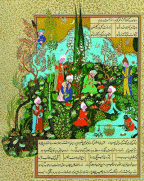Characteristics
of the Shahnameh:

The
history of the Iranian nation: the Shahnameh is first and foremost the
history of Iran as based on collective memories of the Iranians, gathered
from ancient times, modified and regulated during the Sassanian period
and sanctified during the three centuries of Arab rule and influence.
By allowing his narrative to roam over the vast expanse from Kabol and
Zabol and Sistan through the Persian heart-lands to the Caspian Sea
at Mazandaran and again northward across the Oxus into Turanian plains,
Ferdosi united in a fairly consistent whole the essential memories of
that area which his contemporaries were prepared to think of as the
lands of Iran. Ferdosi succeeded in laying down the frontiers
of a greater Iran, and in consolidating them on the foundation of a
common past. The Shahnameh allowed every Iranian to share in the
memories of every section of his country as in a personal possession.
It helped the national consciousness to revert to patriotism with which
provincial loyalties could readily merge.
Strict
adherence to his sources: Although Ferdosiís sources, as he used them,
are not available to us; there are adequate reasons for believing
that he faithfully kept to their content. Ferdosiís faithful
adherence to his sources does not mean that the language was also
left unaltered. It is clear that while the form remained intact,
the descriptive expressions became richer, far more expressive and
necessarily expanded.
Avoidance
of Islamicization: The Shahnameh stands alone among the histories
of Iran written during the Islamic period in avoiding the trend by
which Iranian legends and heroes were given Semitic garb or were equated
with Koranic and biblical figures. This deliberate avoidance
makes the Shahnameh a truly unparalleled ďIranian national history,
and partly explains its unsurpassable success throughout the periods
of national revival.
Effects
of poetic forms: Because the Shahnameh is a national history composed
in epic form, it naturally lacks the straightforwardness and dry matter-of-the-fact
nature of purely historical narrative. It allows supernatural
powers and phenomena to participate in historical events, and shows
little consideration for geographic and chronological accuracy.
Ferdosiís style is that of a superb poet. His epic language
is rich, moving, and lavish that it truly enchants the readers.
The echo of every distich, which in Persian has the rhythm of the
English line: the Pharaohs of Egypt, the Caesars of Rome, is most
pleasing to the senses of the reader or listener. This is one
reason for the survival of the Shahnameh.
Thus,
an examination of the available evidence leads to the following conclusions:
Ferdosi
followed his sources faithfully. Some of these were anti-Arab,
even anti-Islamic, some were pro-Zoroastrian, some also anti-Iranian.
When he is reflecting his sources, the statements of the Shahnameh cannot
be interpreted as Ferdosiís own beliefs.
Nowhere
does Ferdosi personally use a derogatory word about Islam, and when
he describes his own ideas, he has the highest respect for its founder
and his family. In the light of that fact, the Islamic names
in his house (Hassan, Mansur, Qassem) become testimonies of his faith.
The
evidence of the Shahnameh is in harmony with the statements of anthologists
and historians that Ferdosi was a Shiite. This is also clear
from the fact that his tomb became the shrine for the Iranians in
general and the Shiite in particular.
Source: Ferdowsi, A Critical Biography, by A. Shapur Shahbazi, Published
by Mazda Publishers, 1991